A group of goldfinches is often referred to as a "charm". A lone goldfinch visited in the first few years here, but by the winter of 2001-02 numbers increased to a full "charm", with five visiting on several occasions.
By 2006, they appeared to be well-established in the area, and were bringing several young offspring with them to the garden. I noticed, in July 2006, three or four juvenile goldfinches around the seed feeders, along with the adults. The photo below shows one of the young. This bird was temporarily dazed after flying into a window - hence my being able to get so close. It recovered shortly afterwards, and flew away, I'm happy to report.
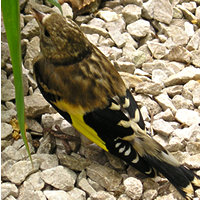
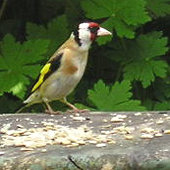
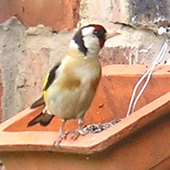
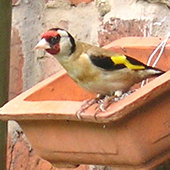
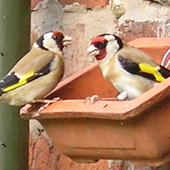
e juvenile goldfinch is rather striking - partly in the adult form with the black and yellow and white, though the other half of the plumage is still speckled brown.
The goldfinches seemed to have been attracted by the thistle seed (also known as Nyjer/Niger seed) bought specifically to attract them, as I'd heard they preferred it. I've noticed more recently that they also eat sunflower seed hearts, which many birds seem to like, and they seem just as happy with these.
As the thistle seed is so tiny, it does tend to fall out of the feeders very easily, and the finches seem to drop a lot of it on the ground. Originally I put the thistle seed into a hanging feeder, but I learnt to my cost how easily this seed germinates after having to remove large clumps of germinating thistle seed from the bark chipping path in Woodland Corner, after the feeder had been hanging there for a while.
I've recently supplied it in a terracotta dish hanging on the wall of Millennium Shed, which seems to have reduced the mess. The area below is paved, so any that falls on the floor can be swept up. The goldfinches have had no problems adjusting to this, as the photos on this page show.
Goldfinches are noisy, excitable birds, and several of them arriving at once is generally something you hear before you see them. They are, of course, easily visible and identifiable - their bright red faces making them unlike any other bird that visits our gardens here in Yorkshire.
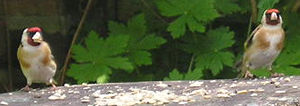
It's good to see that a bird I only saw one of, in the harshest weather, as an occasional visitor, is now an established visitor to the garden. Even better to be visited regularly by the full goldfinch charm.
No comments:
Post a Comment